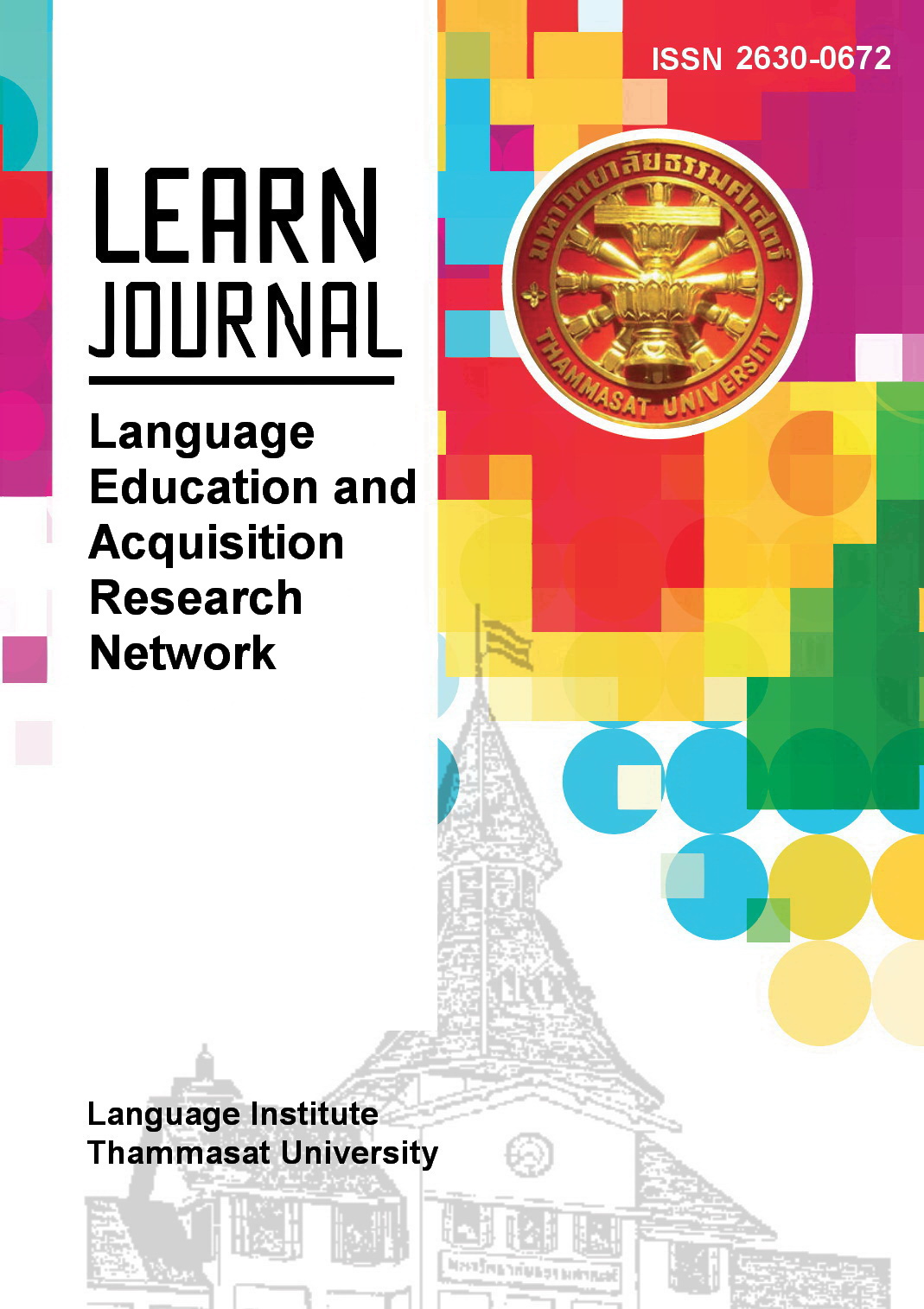From Crisis to Hope: University Students’ Construction and Implications of COVID-19 Discourses in Thailand Through English Essay Writing
Main Article Content
Abstract
The outbreak of the global COVID-19 pandemic has significantly impacted educational institutions worldwide. This study aimed to examine how students constructed discourses about COVID-19 and related terms in their cause-and-effect essays. The sample consisted of 89 essays written by English majors at a large public university in Northern Thailand who completed the English Essay Writing course. This study employed Critical Discourse Analysis (CDA) as the main theoretical framework in which texts were analyzed by using a combination of corpus and content analyses. The findings revealed that students did not explicitly provide a definition of the term “COVID-19” in their essays at the lexical level, but the implications were inferred based on content word selection. The discourses surrounding COVID-19 were classified into four main categories: economy, health, government, and education. In addition to the main discourses, the essays highlighted the concept of global citizenship, as students expressed their opinions about the government as citizens, calling for practical actions to address the challenges faced during the pandemic. In addition to describing these challenges, the essays also reflected a discourse of hope, implying positive psychological responses to the crisis.
Article Details
References
Abdulloh, A., Sarsono, S., & Muslim, I. (2020). English borrowings in COVID-19 pandemic. Journal of English Language and Literature (JELL), 5(2), 17-30. https://doi.org/10.37110/jell.v5i02.101
Anthony, L. (2022). AntConc (Version 4.2.0). Waseda University. https://www.laurenceanthony.net/software
Asif, M., Zhiyong, D., Iram, A., & Nisar, M. (2021). Linguistic analysis of neologism related to coronavirus (COVID-19). Social Sciences & Humanities Open, 4(1), 100201. https://doi.org/10.1016/j.ssaho.2021.100201
Baker, P. (2006). Using corpora in discourse analysis. A&C Black.
Brookes, G. (2021). ‘Lose weight, save the NHS’: Discourses of obesity in press coverage of COVID-19. Critical Discourse Studies, 1-19. https://doi.org/10.1080/17405904.2021.1933116
Hunston, S. (2002). Corpora in applied linguistics. Cambridge University Press.
Jorgensen, M., & Phillips, L. J. (2002). Discourse analysis as theory and method. SAGE.
Kheovichai, B. (2022). Collocation and discursive construction of COVID-19 in WHO director general’s discourse: A corpus-based study. LEARN Journal: Language Education and Acquisition Research Network, 15(1), 10-32. https://so04.tci-thaijo.org/index.php/LEARN/article/view/256712
Laosrirattanachai, P., & Laosrirattanachai, P. (2023). Analysis of vocabulary use and move structures of the World Health Organization emergencies press conferences on coronavirus disease: A corpus-based investigation. LEARN Journal: Language Education and Acquisition Research Network, 16(1), 121-146. https://so04.tci-thaijo.org/index.php/LEARN/article/view/263436
McEnery, T., & Hardie, A. (2011). Corpus linguistics: Method, theory and practice. Cambridge University Press.
Merrita, D. (2020). Discourse structure in students’ scientific articles. Jurnal Bahasa Asing Lia, 1(1), 41-51. https://e-journal.stbalia.ac.id/jurnalbahasaasing-LIA/article/view/56
Muhammad, A., Zhiyong, D., Iram, A., & Nisar, M. (2020). Linguistic analysis of neologism related to coronavirus (COVID-19). Social Sciences & Humanities Open, 4(1), 1-6. https://doi.org/10.1016/j.ssaho.2021.100201
Mweri, J. (2021). Corona virus disease (COVID-19) effects on language use: an analysis of neologisms. Linguistics and Literature Studies, 9(1), 36-47. DOI: 10.13189/lls.2021.090105
Nabila, E., & Abdulrahman, T. R. (2021). An analysis of new English words created during COVID-19. Englisia: Journal of Language, Education, and Humanities, 9(1), 19-32. http://dx.doi.org/10.22373/ej.v9i1.9035
Noroozi, O., Hatami, J., Bayat, A., van Ginkel, S., Biemans, H. J., & Mulder, M. (2020). Students’ online argumentative peer feedback, essay writing, and content learning: Does gender matter?. Interactive Learning Environments, 28(6), 698-712. https://doi.org/10.1080/10494820.2018.1543200
Plipat, T. (2020). Lessons from Thailand’s response to the COVID-19 pandemic. Thai Journal of Public Health, 50(3), 268-277. https://he02.tci-thaijo.org/index.php/jph/article/view/248831
Potts, A., & Baker, P. (2012). Does semantic tagging identify cultural change in British and American English?. International Journal of Corpus Linguistics, 17(3), 295-324. https://doi.org/10.1075/ijcl.17.3.01pot
Prieto-Ramos, F., Pei, J., & Cheng, L. (2020). Institutional and news media denominations of COVID-19 and its causative virus: Between naming policies and naming politics. Discourse & Communication, 14(6), 635-652. https://doi.org/10.1177/1750481320938467
Richardson, J. E. (2007). Analyzing newspapers: An approach from critical discourse analysis. Palgrave Macmillan.
Rodrigues de Andrade, F., Barreto, T. B., Herrera-Feligreras, A., Ugolini, A., & Lu, Y. (2021). Twitter in Brazil: Discourses on China in times of coronavirus. Social Sciences & Humanities Open, 3(1), 100118. https://doi.org/10.1016/j.ssaho.2021.100118
Semino, E. (2021). “Not soldiers but fire-fighters”–metaphors and COVID-19. Health Communication, 36(1), 50-58. https://doi.org/10.1080/10410236.2020.1844989
Sukman, K., & Mhunkongdee, T. (2021). Thai EFL learners’ voices on learning English online during the COVID-19 Pandemic. International Journal of English Language Teaching, 9(2), 1-9. https://eajournals.org/ijelt/vol-9-issue-2-2021/thai-efl-learners-voices-on-learning-english-online-during-the-covid-19-pandemic/
Taylor, C., & Kidgell, J. (2021). Flu-like pandemics and metaphor pre-covid: A corpus investigation. Discourse, Context & Media, 41, 100503. https://doi.org/10.1016/j.dcm.2021.100503
Triana, H. W., Kustati, M., Yusuf, Y. Q., & Reflinaldi, R. (2021). The representation of women in COVID-19 discourses: The analysis of Sara Mills’ critical discourse on media coverage. Journal of Language and Linguistic Studies, 17(1), 553-569. https://www.jlls.org/index.php/jlls/article/view/2043
Unuabonah, F. O., & Oyebode, O. (2021). ‘Nigeria is fighting Covid-419’: A multimodal critical discourse analysis of political protest in Nigerian coronavirus-related internet memes. Discourse & Communication, 15(2), 200-219. https://doi.org/10.1177/1750481320982090
Wintachai, J., Khong, T. D. H., & Saito, E. (2021). COVID-19 as a game changer in a Thai university: A self-reflection. Practice, 3(1), 51-57. https://doi.org/10.1080/25783858.2020.1833233
Yu, H., Lu, H., & Hu, J. (2021). A corpus-based critical discourse analysis of news reports on the COVID-19 pandemic in China and the UK. International Journal of English Linguistics, 11(2), 36-45. DOI:10.5539/ijel.v11n2p36


